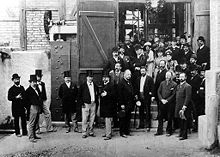Karl von Leibbrand

Karl August Leibbrand , from 1895 von Leibbrand (also Carl ; born November 11, 1839 in Ludwigsburg , † March 13, 1898 in Stuttgart ) was a German civil engineer , Württemberg construction clerk and President of the Ministry of Road and Hydraulic Engineering of the Kingdom of Württemberg .
Life
Karl Leibbrand studied engineering and architecture in Stuttgart. In 1857 he became a member of the Corps Stauffia . After his studies he was a road construction inspector in Oberndorf am Neckar , then a building officer in Stuttgart, then head of the ministerial department for road and hydraulic engineering and later its president. One brother was Richard von Leibbrand .
Karl Leibbrand became known for his numerous bridges . In 1893 he built the Munderking Danube Bridge , the longest cantilever concrete bridge in Germany at the time, where he used a three-hinged arch with joints made of lead plates or cast iron for the first time. In the same year the King Charles Bridge between Stuttgart and Cannstatt was inaugurated. In 1896 the Pont de la Coulouvrenière in Geneva was completed, in which the three-hinged arch he developed was also used. 1896–1897, the second cable suspension bridge in Germany was built according to his plans , the suspension bridge over the Argen between Langenargen and Kressbronn on Lake Constance . His last work was the Eberhardsbrücke in Tübingen, but he did not live to see its inauguration on January 27, 1901.
From 1877 to 1895 with a short break in 1891, Karl von Leibbrand held a mandate as an elected member of the Oberndorf Oberamt in the Württemberg Chamber of Deputies . There he belonged to the faction of the state party.
Honors
- Karl Leibbrand was appointed Knight of Honor of the Württemberg Crown by the King of Württemberg in 1895 and was thus ennobled
- He also received the commentary cross, 2nd class of the Frederick Order
- He was an honorary citizen of Cannstatt , Balingen and Schramberg
- He was awarded the Telford Prize by the Institution of Civil Engineers for his services to the development of the three-hinge arch bridge
plant
buildings
- 1885: Enz Bridge near Höfen (demolished)
- 1886: Guldebrücke near Wildbad
- 1886: Glatt Bridge near Neuneck
- 1887: Murrbrücke near Marbach
- 1890: Forbachbrücke Baiersbronn
- 1891: Railway bridge in Ehingen
- 1891: Hydroelectric power station in Lauffen am Neckar (demolished)
- 1893: Munderkinger Danube Bridge (destroyed)
- 1893: King Charles Bridge between Stuttgart and Cannstatt (destroyed)
- 1895: Danube bridge Inzigkofen (destroyed)
- 1895: Neckar bridge near Mühlheim
- 1895: Leinbrücke Heuchlingen
- 1896: Neckar bridge near Gemmrigheim
- 1897: Suspension bridge over the Argen between Kressbronn on Lake Constance and Langenargen
- 1901: Eberhards Bridge in Tübingen
Fonts
- (with Albert Eugen Adam): The anniversary column in Stuttgart. Stuttgart 1893.
- Concrete bridge over the Danube near Munderkingen. Wasmuth, Berlin 1894. (Reprint from the Zeitschrift für Bauwesen , year 1894)
- The King Charles Bridge over the Neckar between Stuttgart and Cannstatt. In: Zeitschrift für Bauwesen , Volume 45, 1895 ( online as a PDF document with 54.82 MB ), column 61–104.
- Arched bridges. Engelmann, 1897.
literature
- o. V .: † Karl von Leibbrand. In: Schweizerische Bauzeitung. Vol. 31, No. 12, March 19, 1898, pp. 90-91, online .
- Frank Müller-Thoma: Everything for a bridge. For the 100th of the oldest cable suspension bridge in Germany. Brunnenwässerle-Verlag, Langenargen 1998, ISBN 3-00-002768-8 .
- Frank Raberg : Biographical handbook of the Württemberg state parliament members 1815-1933 . On behalf of the Commission for Historical Regional Studies in Baden-Württemberg. Kohlhammer, Stuttgart 2001, ISBN 3-17-016604-2 , p. 498 .
Web links
- Ulrich Boeyng: Wide-span bridge vaults in the former Kingdom of Württemberg. In: Structural Engineering. 83, 2006, pp. 511-514, doi : 10.1002 / bate.200690094 .
- The Tübingen Eberhardsbrücke at Tüpedia.de
Individual evidence
- ^ Carl Heydt: Chronicle of the Corps Stauffia zu Stuttgart , 1960, p. 28
- ↑ Ingersheimer Leibbrand Tribe
| personal data | |
|---|---|
| SURNAME | Leibbrand, Karl von |
| ALTERNATIVE NAMES | Leibbrand, Carl von; Leibbrand, Karl August von; Leibbrand, Karl; Leibbrand, Kral August |
| BRIEF DESCRIPTION | German civil engineer, Württemberg construction officer |
| DATE OF BIRTH | November 11, 1839 |
| PLACE OF BIRTH | Ludwigsburg |
| DATE OF DEATH | March 13, 1898 |
| Place of death | Stuttgart |

